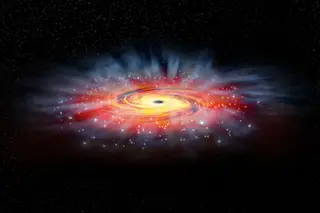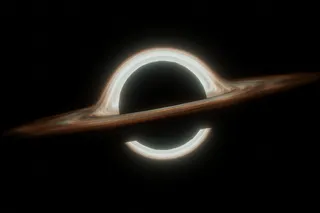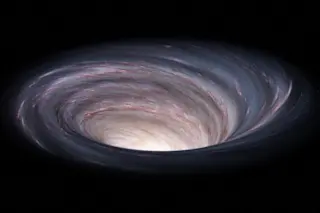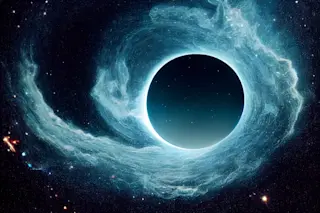High winds are the norm at the center of the Milky Way. Astronomers have now clocked suns orbiting the galactic core at a staggering 3,000 miles (4,800 kilometers) per second. At this rate, Earth would complete its orbit around the sun in a mere three days. What lurks at the galaxy’s core that can accelerate stars to such speeds?
Astronomers have considered various possibilities. Does the center of the galaxy harbor a tight cluster of superdense stellar remnants (neutron stars)? Or perhaps a huge ball of subatomic neutrino particles?
But these and other more exotic possibilities were eliminated in the spring of 2002 when a star called S2 swept down in its highly eccentric orbit and passed within 17 light-hours of the Milky Way’s center — a minuscule distance in galactic terms. In 17 hours, light travels three times the distance between Pluto and the sun.
Only one object is compact enough and has sufficient mass to accelerate stars to such a high speed: a supermassive black hole. Astronomers had suspected that a black hole must lie at the Milky Way’s core, but plotting the orbit of S2 and other stars dramatically strengthened the evidence.
Our central black hole is small by the standard of what lurks in the hearts of other galaxies. Observations of the giant elliptical galaxy M87 suggest the presence of a black hole 6 billion times more massive than the sun. The interaction of two supermassive black holes probably produces the intense X-rays streaming from the galaxy NGC 6240. The Andromeda Galaxy may harbor a black hole of 140 million solar masses.
In comparison, our galaxy’s black hole is paltry — containing about 4 million solar masses. But its nearness means we can study it in detail, including charting the orbits of dozens of stars buzzing around it like bees. The stellar-mass black holes found in some binary star systems are too small to be observed in detail by telescopes anytime soon. So, the best chance of seeing what happens in the bizarre neighborhood around a black hole is to study the one at the Milky Way’s heart. So far, it has not failed to surprise us.

Bright stars surround the supermassive black hole at the Milky Way's center. (Credit: NASA/CXC/M.Weiss)
NASA/CXC/M.Weiss
Bright stars surround the supermassive black hole at the Milky Way’s center. (Credit: NASA/CXC/M.Weiss)
The Inner Realm
The galactic center lies about 26,000 lightyears from Earth toward the constellation Sagittarius. It is a region of the sky where bright stars mingle with dark clouds of gas and dust. The actual center is too obscured to reveal much when astronomers observe it in visible light. What we know of it comes from data collected in infrared and radio wavelengths. These wavelengths can pass through the dust and gas and reach Earth-based telescopes.
Astronomers have long known that the strongest source of radio energy in the sky, after the sun, lies at the galactic center. This broad core region is called Sagittarius A, often abbreviated as Sgr A.
Sgr A hosts dozens of individual radio sources. One is called Sagittarius A*, pronounced “Sagittarius A star.” It lies at the very center of the galaxy and coincides with the position of the supermassive black hole. Everything else rotates clockwise (from Earth’s point of view) around this point, making it the dynamic center of the galaxy. And it is a very busy neighborhood.
Surrounding Sgr A* at a distance of several light-years, a shell of dust rotates counterclockwise — opposite to the galaxy’s general rotation. Lying inside the shell, and turning in the same direction, is a small spiral structure with three arms.
Each arm is a stream of hot gas set aglow by nearby stars. The gas flows toward the center of the spiral where Sgr A* lies. Radio images taken a few years apart revealed the spiral is rotating. More recently, a close-up look at Sgr A* with new imaging technology has revealed the amazingly powerful gravity of the object the spiral encircles.
Stellar Raceway
In 2002, a team of astronomers led by Reinhard Genzel of the Max Planck Institute for Extraterrestrial Physics in Garching, Germany, published the first scientific paper announcing S2’s 17-light-hour close encounter with Sgr A*. Using the European Southern Observatory’s (ESO) Very Large Telescope (VLT) in Chile, Genzel’s group caught S2 as it rounded Sgr A* at a fantastic speed. The VLT’s adaptive optics reduces atmospheric blurring, allowing astronomers to chart S2’s position more accurately.
For the previous decade, the astronomers had been plotting S2’s orbit, mostly with ESO’s 3.6-meter New Technology Telescope, also in Chile. The orbital positions allowed the researchers to calculate S2’s orbital period around Sgr A* as about 16 years. The orbit is quite eccentric. The star swoops in to within 17 light-hours at its closest approach to Sgr A*, but then sweeps outward to a distance of some 10 light-days at its farthest point. To produce such an orbit requires a compact black hole with about 4 million solar masses.
Genzel and his colleagues were not the only ones tracking S2 and the many other stars zipping around Sgr A*. Astronomer Andrea Ghez’s Galactic Center Group at UCLA has studied S2 and its motions with the 10-meter Keck Telescope in Hawaii. In 2000, the team reported evidence that S2’s path is curved — early evidence S2 is orbiting something at the galactic center. The UCLA team later discovered S2’s close orbital distance to Sgr A* at about the same time as Genzel and his colleagues.
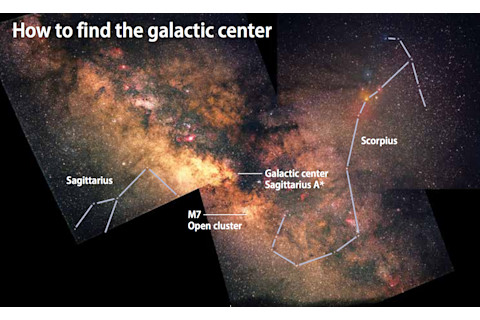
Sagittarius A*, at the Milky Way's core, lies in the constellation Sagittarius and to the east (left) of Scorpius. The region is rich with star clusters and nebulae. It’s a perfect place to explore with binoculars under dark skies. (Credit: Sky images: Gerald Rhemann; Constellation outlines: Astronomy: Roen Kelly)
Sky images: Gerald Rhemann; Constellation outlines: Astronomy: Roen Kelly
Sagittarius A*, at the Milky Way’s core, lies in the constellation Sagittarius and to the east (left) of Scorpius. The region is rich with star clusters and nebulae. It’s a perfect place to explore with binoculars under dark skies. (Credit: Sky images: Gerald Rhemann; Constellation outlines: Astronomy: Roen Kelly)
Stars of Mystery
Extensive observations in recent years by Genzel, Ghez, and others paint a fascinating picture of the flurry of activity around Sgr A*. One of the most challenging observations astronomers have performed on the galactic center stars is spectroscopy, or separating starlight into its component wavelengths. A spectrum reveals much about a star’s composition, age, and mass.
Gathering enough light from a distant star to take a good spectrum requires tracking the target through a narrow slit for many hours. Any small shift in the slit’s position contaminates the spectrum with light from other sources. Spectroscopy is especially challenging in the crowded star field around Sgr A*, where the density of stars is more than a million times higher than in our stellar neighborhood.
In 2003, Ghez took a spectrum of S2 with the Keck Telescope using its adaptive optics system. The slit trained on the star was only 0.04 inch (1 millimeter) wide. Keeping this narrow gap locked on S2 was like aiming a gun sight on an object the size of a basketball 1,000 miles (1,600 km) away.
The spectrum revealed S2 to be a heavyweight star some 15 times the sun’s mass. Such large stars exhaust their hydrogen supply quickly — in this case, in less than 10 million years. That means S2 must be younger than 10 million years. In addition, the star has a very hot atmosphere, as do other stars orbiting close to Sgr A*. This also indicates a relatively young age.
In short, these stars formed 3 to 6 million years ago. This raises a major problem: Why are such young stars orbiting so close to Sgr A*, a region of intense magnetic fields and strong gravitational forces that would normally prevent star formation?
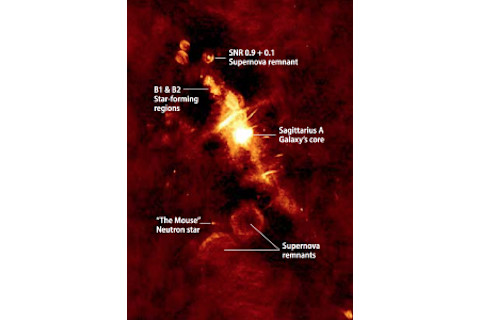
Radio astronomy reveals hidden features of the Milky Way’s center, including remnants of supernova explosions and stars forming in vast clouds of gas and dust. (Credit: W.M. Goss/C. Lang/VLA/NRAO)
W.M. Goss/C. Lang/VLA/NRAO
Radio astronomy reveals hidden features of the Milky Way’s center, including remnants of supernova explosions and stars forming in vast clouds of gas and dust. (Credit: W.M. Goss/C. Lang/VLA/NRAO)
Stellar Masquerade
One possible explanation is that S2 and its companions may be old stars masquerading as young ones — “a phenomenon we understand quite well in Los Angeles,” Ghez once quipped to a science reporter.
In this case, what seem to be young stars are actually the cores of older suns that collided and merged. The collisions could have stripped away the suns’ cool outer layers, exposing their hot interiors. The result would be a cluster of massive stars that appear much younger than they really are.
But there’s a problem with this scenario. A collision violent enough to strip away the outer layers should also annihilate both stars and leave only a trail of hot gas. And so astronomers have proposed alternatives. For example, perhaps the stars formed elsewhere and migrated inward under the black hole’s gravitational pull.
The problem with this explanation is that most active star formation in the Milky Way occurs far from the core, in its spiral arms. It would take the stars too long to migrate as close to the center as S2.
Dense dust clouds do lie closer to Sgr A* than the spiral arms, to within a few dozen light-years. Stars are probably forming inside of them. It’s conceivable that a cluster of young stars could spiral down to within a few light-years of the center — and do so in less than 10 million years.
The problem here is that to get closer to the black hole, the stars would have to shed angular momentum — the quantity that keeps planets in nice safe orbits around stars instead of “falling” directly into them.
One way to lose angular momentum is to bump into other stars. But it’s difficult to imagine how stars could endure this process and migrate to within light-hours of Sgr A* without being destroyed. Besides, the process should leave behind a trail of stars toward Sgr A* for a long distance, something astronomers have not yet seen. Instead, the shell of stars orbiting close to Sgr A* has a definite outer edge.
Star Birth in a Disk
Another possibility is that Sgr A*’s central cluster stars formed within a rotating disk of gas and dust immediately surrounding the black hole. In fact, some observations suggest most stars in the central cluster orbit roughly in the same plane — an arrangement reminiscent of the major planets in our solar system. The planets formed in a disk of gas and dust, so perhaps S2 and its fellow travelers did, too.
However, not all astronomers agree the central cluster has a disklike structure. Another caveat: To spawn stars, the disk would need to be dense enough to withstand the black hole’s tidal forces.
It’s also conceivable that Sgr A*’s companion stars formed in dust clouds circling at high speed within a few light-years of the galactic center. Collisions between the clouds could have spawned shock waves, triggering star formation. As the result of collisions between the clouds, they and the new stars embedded within them could have shed enough momentum to settle into orbits around the black hole. The galactic core’s strong magnetic field would have gradually swept the leftover interstellar dust and gas away from the black hole. What would remain is a disk of young stars in close orbit to Sgr A*.
This scenario explains much of what astronomers see in the galactic core, although not all. UCLA astronomer Brad Hansen thinks he has a viable alternative: Hot young stars now orbit the Milky Way’s central black hole because a second smaller black hole dragged them there.
The process begins in a crowded young star cluster, dozens of light-years from the galactic center. Collisions between big stars in the cluster’s core form an intermediate-sized black hole in the range of 1,000 to 10,000 solar masses. Gradually, the black hole would migrate toward the galactic center, dragging its cargo of “hostage stars” along with it. Hansen argues this is the only way to quickly transport massive young stars into the galactic center from an outside star-birth location.
All the black-hole ferry scenario lacks is hard evidence to support it. If a second black hole orbits the primary black hole in the galactic core, its presence might be detectable. Its tug on Sgr A* might cause a detectable wiggle. Clearly, astronomers still have a lot of work left to fully understand the processes at work in the galactic core.
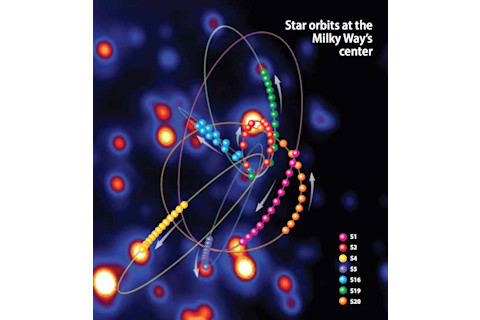
Dozens of young stars orbit at high speeds around the galaxy’s central black hole. By plotting the stars’ positions for years, astronomers calculated their orbits and estimated the mass of the black hole they encircle. (Credit: Astronomy: Jay Smith, after Andrea Ghez (UCLA))
Astronomy: Jay Smith, after Andrea Ghez (UCLA
Dozens of young stars orbit at high speeds around the galaxy’s central black hole. By plotting the stars’ positions for years, astronomers calculated their orbits and estimated the mass of the black hole they encircle. (Credit: Astronomy: Jay Smith, after Andrea Ghez (UCLA))
Imaging The Black Hole
Fast-moving stars like S2 remain the best evidence that a black hole lies at the heart of the Milky Way. Other support includes periodic bursts of infrared light from Sgr A*. The bursts suggest the black hole spins, completing a turn every 17 minutes. Astronomers have also detected strong radio pulses coming from Sgr A*. This may indicate that packets of ultra-hot gas and dust are falling into the black hole.
But this is all still circumstantial evidence. The definitive proof might come if astronomers could actually image the black hole’s edge or “event horizon,” beyond which no light or matter can escape.
Radio energy passes through the veil of obscuring dust and gas around the galactic center, providing a way to directly image a black hole. By itself, a black hole is essentially invisible. But it would be detectable as a silhouette against the accretion disk of gas spiraling into it. The gas emits energy as it accelerates to high speeds around the black hole.
Light follows a highly curved path near a black hole, making its silhouette appear wider than it actually is. Bright rings or arcs, formed as the black hole bends or “lenses” light from background sources, might protrude from the silhouette’s edges.
In 2008, radio astronomers announced an important milestone in the study of our galaxy’s black hole. By combining the power of three radio telescopes, researchers detected features around Sgr A* as small as 31 million miles (50 million km) across. The study found that radio emission from Sgr A* is offset from the black hole, perhaps because it comes from an accretion disk. Astronomers hope the Event Horizon Telescope — a nearly Earth-sized radio observatory comprising about a dozen separate instruments — will be able to image the black hole’s silhouette in the next few years.
Whatever the result, imaging the Milky Way’s central black hole will put the existence of black holes on a firmer footing and perhaps reveal important new insights about the evolution of galactic cores. A failure to see it will bring into question what we understand about the heart of our own galaxy — including the origins of the highspeed roller derby of young stars whizzing around its center.
This story originally appeared in Astronomy‘s special issue, The Milky Way Inside And Out.


